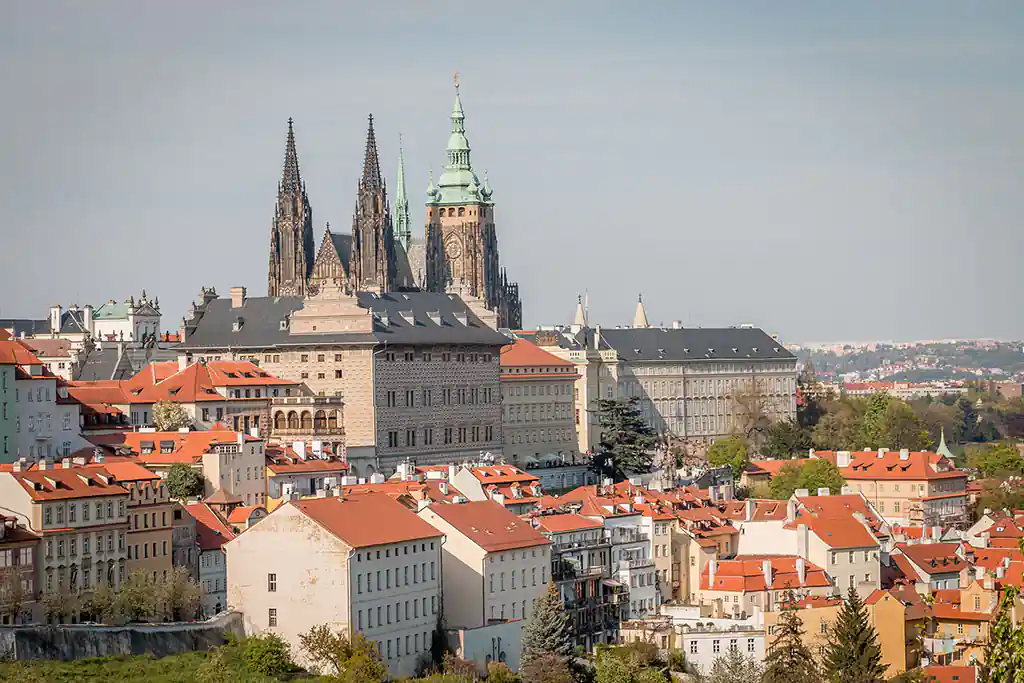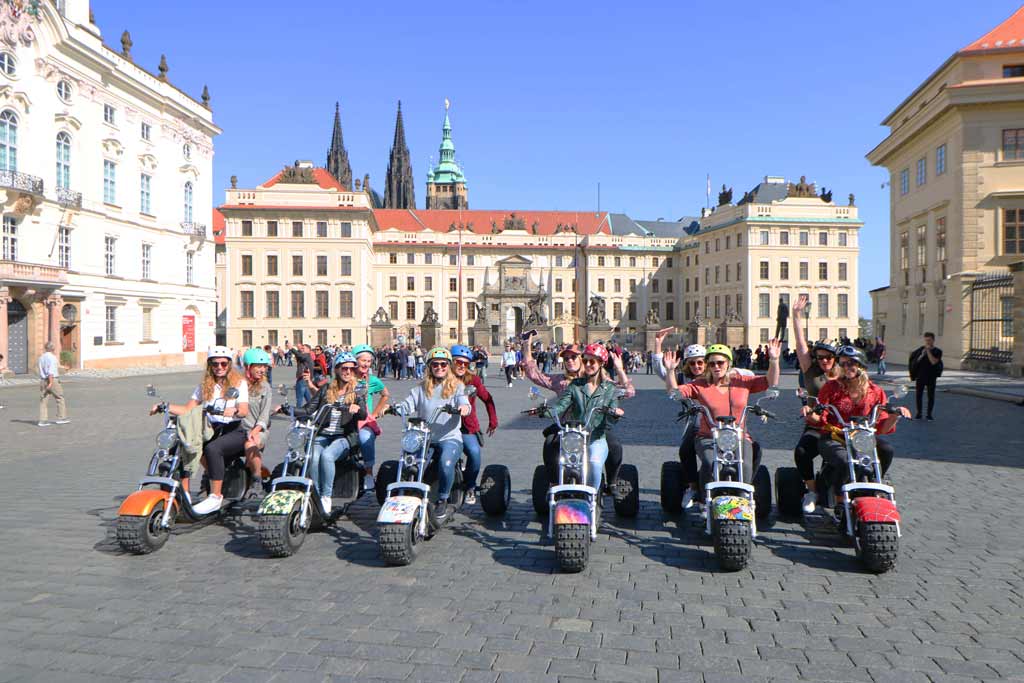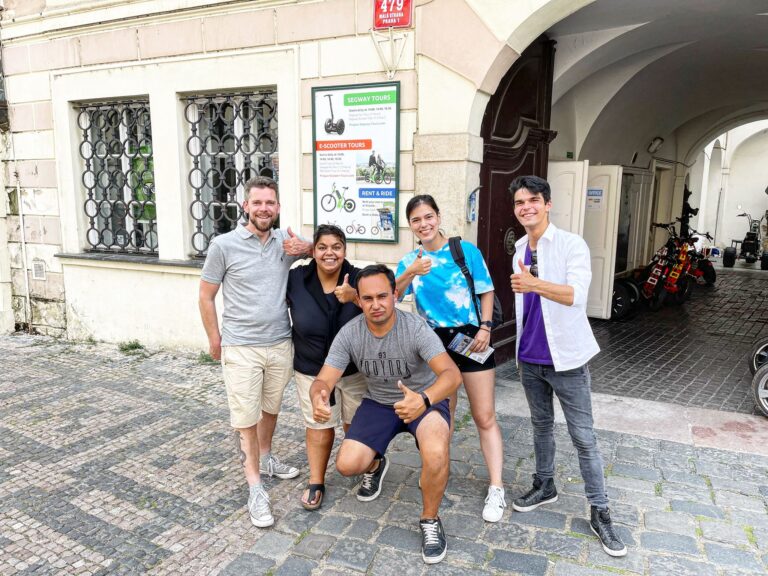According to records, Prague Castle is the largest castle complex in the world. The three courtyards and a number of magnificent buildings cover more than 7 hectares, so be prepared to see and walk a lot. Depending on how much time you have and what your interests are, you can decide which interiors you want to visit.
Please check the official Prague Castle website for current opening hours and admission prices.

If you want to spend a few days in Prague, see some sights and use public transport, you can save some money and time with Prague Card, which includes free entrance to Prague Castle.
How to get to Prague Castle
There are several ways to get to Prague Castle. Some are more difficult, some are easier. But in any case, it is best to go to the Castle accompanied by a guide.
Getting to Prague Castle on foot
If you want to reach the castle on foot, you have several options:
Nerudova Street – walk up the picturesque (and rather steep) Nerudova Street from Malostranské náměstí and take a sharp right at the top onto Ke Hradu. You will then be in front of the main entrance to the chateau.
Castle stairs (Zámecké schody) – walk up Nerudova from Malostranské náměstí and quickly turn right into Zámecká Street. Then turn left to climb up the romantic chateau stairs, which will lead you to the garden on the fortress walls (Zahrada na Valech).
Old chateau staircase (Staré zámecké schody) – the staircase starts near the Malostranská metro station and leads you to the beginning of Jiřská Street. You will be rewarded with one of the most beautiful views of Prague.
Arrival to the Castle by streetcar
If you take the streetcar, you will save yourself the walk uphill or the stairs, and the ride is very picturesque. Take streetcar line 22 (for example, from Národní třída or Malostranská metro station) and get off at one of the following stops:
Královský letohrádek – if you get off here, you can start with the Royal Garden, the Belveder and the Ballroom and then walk across the bridge over the Deer Moat to the Second Courtyard.
Note: The Royal Garden and the Deer Moat are closed from November to March.
Pražský hrad – as the name suggests, this is the main Prague Castle stop. Get off here if you want to reach the Second Castle Courtyard.
Pohořelec – if you get off here, you can walk through Hradcany, past Strahov Monastery and Loreta to the castle and get to the main entrance. This is probably the most beautiful way (and our favorite).
A good option is to take the streetcar up to the castle and then walk back down.
You can find streetcar schedules at dpp.cz.
Electric scooter or Trike tour to the Castle
Providing tours in Prague on Segway since 2008, our company cares of the comfort of our guests. We offer live guided tours making it more easy, so now you have three options of how to go to Prague Castle: by electric scooter, by Trike Harley and by Segway.
During the tour, the guide will show you the free part of the Castle, tell the story and show you the pearls of architecture invisible to ordinary visitors. When planning your excursion in advance, you can see the changing of the guard at the main gate of the Prague Castle.
After visiting the Сastle, you will continue your tour and visit the Strahov Monastery, which offers the best view of Prague Castle, as well as the red tiled roofs of the Old Town.

History of Prague Castle
Prague Castle (Pražský hrad) was founded around 880 by Prince Bořivoj of the Přemyslid dynasty. The first stone building on the castle grounds was the Church of the Virgin Mary, of which only remains can be seen today. In the 10th century, the Basilica of St. George was founded and the first Czech monastery – the Monastery of St. George – was established. The St. Vitus Rotunda, also from the 10th century, was replaced in the 11th century by the St. Vitus Basilica, on the site of which the St. Vitus Cathedral stands today.
From the 10th century, Prague Castle served as the seat of Bohemian princes and later kings, as well as the seat of the Prague bishop.
Prague Castle experienced its greatest heyday during the reign of Charles IV. (1346-1378), when it became the seat of the Holy Roman Emperor. The royal palace was rebuilt, the fortifications were strengthened, and construction began on St. Vitus Cathedral, which followed the style of French Gothic cathedrals of the time.
During the reign of Charles’ son Wenceslas IV, the expansion of the castle continued, but the Hussite Wars (1419 – 1437) and the following decades, during which the castle was abandoned, led to its decline.
After 1483, King Vladislav Jagellon moved into the castle and the complex grew again. New fortifications and watchtowers (the Powder Tower, the New White Tower and Daliborka) were built. The royal palace was further rebuilt and enlarged by the grandiose Vladislav Hall, which is one of the first testimonies of the Renaissance style in the Czech lands.
When the Habsburgs took over the Bohemian throne in 1526, the Renaissance was in full swing in Europe. The seat of power was moved to Vienna and Prague Castle was used mainly for recreational purposes. The royal garden was laid out, and in the 16th century entertainment venues such as the Belvedere and the Ballroom were added. The Cathedral and the Royal Palace were rebuilt. New residential buildings were erected to the west of the Old Royal Palace.
The reconstruction of the castle reached its peak under Emperor Rudolf II, who became King of Bohemia in 1575 and moved his court back to Prague. He wanted to transform the castle into an elegant center of power that would attract foreign artists, scientists and diplomats. The north wing of the palace and the Spanish Hall were added to house the emperor’s extensive art and science collections.
The Defenestration of Prague in 1618 ushered in a long period of wars in which Prague Castle was damaged and looted and rarely served as a seat of power.
The last major reconstruction of the castle took place in the second half of the 18th century, when it took on the style of a castle. However, the seat of power was once again in Vienna and the castle continued to deteriorate.
In 1848, Emperor Ferdinand V moved to Prague Castle. The Holy Cross Chapel in the Second Courtyard was rebuilt, the Spanish Hall and the Rudolf Gallery were remodeled.
After the collapse of the Austro-Hungarian monarchy in 1918, Prague Castle became the seat of the first president of independent Czechoslovakia, Tomáš Garrigue Masaryk. Slovenian architect Josip Plečnik was commissioned to carry out some necessary reconstructions. The construction of St. Vitus Cathedral was completed in 1929.
After 1989, many areas of the castle were opened to the public for the first time in history, including the Royal Garden, the Ballroom, the Southern Gardens or the Imperial Stables. Today, Prague Castle is the seat of the Czech President and the most important national cultural monument of the Czech Republic. A number of priceless works of art, historical documents and the Czech crown jewels are kept here.



